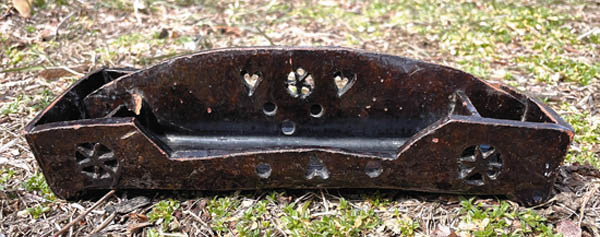A Rare Example Of 19th-Century Red Earthenware From Parkesburg, Chester County, Pa.
Folk Art Redware Desk Caddy Found In Canada
By Justin W. Thomas - April 14, 2023
Located a little over 40 miles west of Philadelphia in Parkesburg, a borough in Chester County, Pa., is the Fountain Inn, a tavern built in about 1734. Located along Strasburg Road, it served as a stopover for those traveling between Philadelphia and Lancaster and at the time was the countrys largest inland road. Today, the building stands at 131/133 Main Street. The inn ceased operation as a tavern around 1836 and became Parkesburgs first post office. The area was originally settled by migrants predominantly of Scottish-Irish descent, some of whom were Quakers, in search of an agrarian lifestyle or a community whose economy was based on producing and maintaining crops and farmland. The town was also named after John G. Parke (1761-1837), a prominent politician and landholder in the area. He had hoped his land and surrounding area would develop into an industrial town similar to those in Europe. According to the book Genealogy of the Parke Family: Nine Generations From Arthur and Mary Parke 1720-1920, by John P. Wallace (b. 1837) in 1920, John G. Parke was a member of the states General Assembly in 1818, a justice of the peace for many years; he was elected a ruling elder of Upper Octoraro Church, and was a prominent man in the community in which he lived. He was the owner of 200 acres of land through which the Pennsylvania Railroad was, in 1830, being constructed. He devoted all his energy to building up a town on his estate, with what success is evidenced today by the borough of Parkesburg with its three thousand inhabitants. Growth really got started in 1831, when the tracks of the Philadelphia and Columbia Railroad were laid through Parkesburg. However, despite all of the travel that went through Parkesburg in the 1800s, there does not appear to be any documented household pottery production. This is likely partially a result of the amount of wares that were produced in the surrounding communities and counties during this period. But with that said, an object of particular interest was rediscovered in Canada that may shed some light on a possible forgotten potter of red earthenware production connected to Parkesburg in the 1800s. A Red Earthenware Object Inscribed Parkesburg The object was in the collection of longtime Canadiana and pottery collector John Wine, a retired psychologist in Ontario, Canada. Much of his pottery collection was sold a few years ago through Miller & Miller Auctions in New Hamburg, Ontario, although this piece was not included in any of the auctions and was sold privately in 2020. It is believed to have been found in Ontario and is an example of something that migrated north from Pennsylvania. The utilitarian shape is unusual and can be described as a hand-formed 19th century footed red earthenware desk caddy for keeping inkwells, pens, and quills. The piece is adorned with a dark brown glaze and decorated with reticulated cutouts of hearts, fylfots and other designs. Wares related to this type of decorative piece can be found in the Philadelphia Museum of Art, the Metropolitan Museum of Art, Winterthur, and the National Museum of American History at the Smithsonian Institute. In form and design it relates to red earthenware and stoneware inkstands made in Pennsylvania, which were constructed with a removable inkwell and sander. Many of the surviving inkstands today made by American potters were inspired by similar objects produced in Continental Europe. The base is what is most important on this piece, since it bears what appears to be one or possibly two inscribed names, which are illegible with the inscription partially infilled with glaze, but the location is legible, reading Parkesburg. Interestingly, while Nathan Frame was serving as the postmaster in 1836, it is documented that the postmark was Parkesburgh, and the h was dropped from the postmark to the present Parkesburg in July 1894. But even though this red earthenware object is spelled without the h, it likely dates from the early to mid-1800s. Nonetheless, I am curious to determine if this piece has any history with John G. Parke or his family, considering the major role he played in developing the town on the land he owned before his death in 1837. Later in the 1800s, Parkesburg also saw involvement with the tobacco industry, the areas largest department store opened in 1857, and the Parkesburg Iron Company also emerged, which operated from 1872 to 1926, manufacturing as many as 1 million charcoal iron tubes annually. It should also be noted that Johns son, Joseph G. Parke, is the one who wrote Parkesburg on a 19th century map submitted to the state agency that had taken over the function of the Philadelphia and Columbia Railway System. This red earthenware desk caddy is an interesting piece of regional history likely made in Chester County that, through migration waves, ended up in Ontario. Sources Mowday, Bruce Edward and Parkesburg Free Library. Parkesburg. Arcadia Publishing, 2009. Mullen, Marris W. Parkesburg Our Town History 1681-1972. Burough of Parkesburg, Pa. Thomas, Justin W. A 19th-Century Inkstand from Etna, Ohio: An Examination Of The Work Attributed To Swiss Potter Jacob Rudolph (1822-63), Working In Ohio. Antiques & Auction News, March 12, 2021. Wallace, John P. Genealogy of the Parke Family. N.P.






SHARE
PRINT